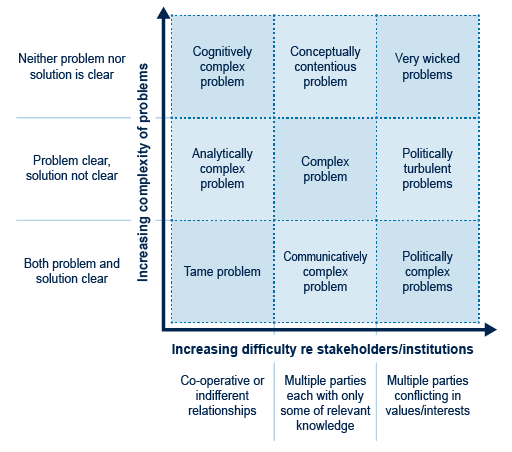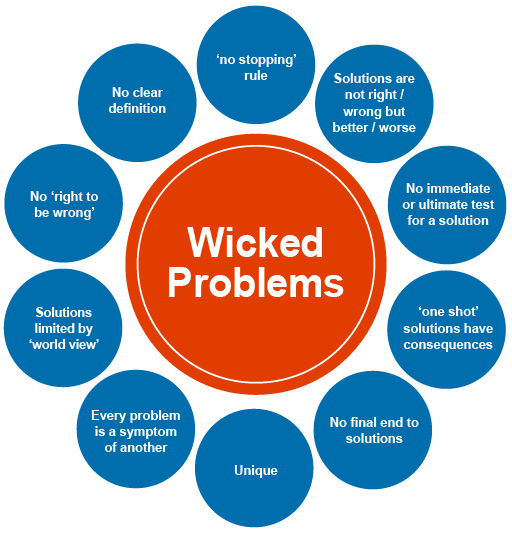4 The complexity of problems
Of course, the scope of the strategy and detail behind the execution plan will depend on the type of problem you are trying to solve and the urgency within which you are trying to solve it. Some plans need to rapidly react to a situation and others have time to plan and explore 'what could be possible'.
Stage 1 of Sola and Couturier’s (2014) five stages in the strategy development process is ‘Assessing the situation’ and Stage 2 is ‘Identifying the core challenges and setting the goals’. Both of these together give you a view of the problem you are trying to solve.
There are many ways of describing, analysing, and resolving problems depending on their level of difficulty and complexity as shown in the figure below. There are even concepts that describe complex problems in terms of ‘tame’ to ‘wicked’ (Alford and Head, 2017).
John Alford and Brian Head (2017) suggest that a ‘problem' is more likely to be wicked if several conditions (or most of them) are present. These include the following.
- Structural complexity: inherent intractability of the technical (i.e., non-stakeholder-related) aspects of the problem.
- Knowability: Not only is there little knowledge about the issue, but the nature of the problem or its solution is such that it is unknowable – that is: the relevant information is hidden, disguised or intangible; it comprises multiple complex variables; and/or its workings require taking action to discover causal links and probable outcomes.
- Knowledge fragmentation: the available knowledge is fragmented among multiple stakeholders, each holding some but not all of what is required to address the problem.
- Knowledge-framing: some of the knowledge receives either too much or too little attention because of the way it is framed, thereby distorting our understanding.
- Interest-differentiation: the various stakeholders have interests (or values) which are substantially in conflict with those of others.
- Power-distribution: There is a dysfunctional distribution of power among stakeholders, whereby very powerful actors can overwhelm less powerful ones, even if the latter constitute a majority consensus; or whereby sharply divided interests are matched by sharply divided power.
Russell Ackoff coined the term ‘Messes’ in 1974 to distinguish between different types of problems. ‘Messes’ are larger in scale than ‘difficulties’ and have more serious implications due to the larger number of people affected, the longer duration of the situation, and they are more complex. Additionally, there is an uncertainty element to ‘Messes’, and it is not easy to succinctly define the situation or problem.
These problems can be categorised as shown in the table below.
Wicked issues are difficult to define and change with time, several stakeholders are involved, problem root cause analysis leads to alternate solutions that diverge into other possible solutions (i.e., each resolution creates new issues) |
Wicked Mess wicked and has the complexity of interrelated issues, suboptimal solutions pose other problems |
Tame issues can be clearly defined, few stakeholders are involved, problem root cause analysis leads to alternate solutions that converge into a single possible solution (i.e., resolution is definitive) |
Tame Mess but has the complexity of interrelated issues, suboptimal solutions pose other problems |
In addition, Rittel and Webber (1973) identified ten characteristics of wicked problems, which helps to further understand the complexity of considering what may be in involved with approach problems you have. See Figure 18.
By its very nature, you may not be able to solve the overall wicked problem, but you can mitigate some of the consequences. This requires being open to ideas and experimenting with different approaches, such as human-centred design or an interdisciplinary focus (IDEO, 2015).
While wicked problems have frameworks from which to consider them, another approach is to think about problems as ‘intractable’ − those for which there is no obvious approach to solving them. As you consider a problem you reframe it and try to make sense of the problem and look for different paths that will help to mitigate the issue. This draws from taking a more human-centred approach to problem solving.
That involves observing, using empathy to explore the problem further, to uncover what at first might not be obvious, generating ideas, with test-and-learn activities to gather feedback, prior to implementing a potential solution.
Activity 10 Reframing your problem
Think about a complex and challenging scenario in your life or work-life and take a moment to judge whether your situation/problem is a tame or wicked mess, and if it is intractable? Then start to reframe your situation/problem to explore if there are elements that could be tamed.
Make some notes about this process in the box below.


